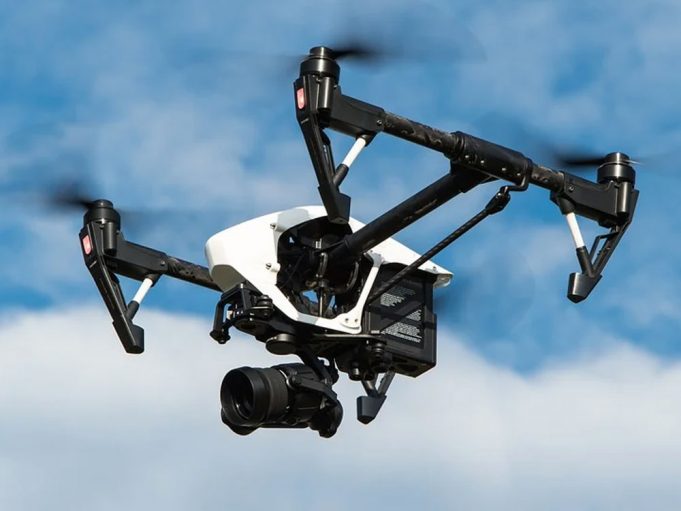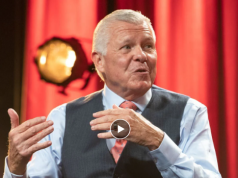I
n more than 40 years as a referee at the high school, college and professional levels, Bruce Maurer has seen his share of the unexpected on a football field.
Then last summer, something he had never seen before popped onto his radar above a 7-on-7 football skills camp in Dublin, Ohio.
“We were just officiating, and I was the back judge, and I started to hear this whirring noise,” said Maurer, who has worked major college and NFL games, and now officiates football, basketball and lacrosse. “I see this thing, and my brain is in officiating mode, and I go, ‘Oh, my Lord, that’s a drone.’ That’s the first time I’ve ever seen a drone.”
Drones are making headlines and newscasts as their popularity grows. They are used in various ways, including in the military, for commercial use and in sports, in practices and/or games. The small, unmanned aircraft systems that resemble radio-controlled helicopters have been spotted at prominent professional, college and high school events. They’ve created a stir in the air over jam-packed college football stadiums in Wisconsin, Tennessee and Texas, at the U.S Open tennis tournament in New York and at an NFL preseason game in Charlotte.
Equipped with a camera, drones are giving operators a look at the field of play from a new perspective at a reasonable cost. Drones range from less than $50 to advanced models that can cost thousands of dollars.
After Maurer’s first sighting, it didn’t take him long to realize a serious issue was hovering overheard — for administrators, fans and officials who work the games.
“Obviously, some people would have an issue with safety,” Maurer said. “The thing I saw was literally flying directly overhead while (the teams) were playing. Then there is a cost issue: if one school can afford it and another school can’t, that creates a problem.”
Maurer’s sighting turned out to be a drone used to get promotional video of the football camp. But as drones continue to fill the air, sports administrators and officials, and even the Federal Aviation Administration (FAA), are scrambling to keep pace.
Big Stadiums a Big No-No
While drones are being used at practices for sports teams of all different levels to give coaches a new perspective on play, the FAA has made it clear for major college and professional events: No drones allowed.
In October, the FAA issued an updated ban on flights over open-air college and professional stadiums with seating capacities of 30,000 or more. The FAA’s guidelines now ban unmanned or remote-controlled aircraft “where either a regular or postseason MLB, NFL or NCAA Division I football game is occurring.” The FAA update also banned flights at NASCAR and Indy Car races.
Among the few exceptions: authorized flights for broadcast coverage. The ban includes the area within a three-mile radius of the event and is in effect from one hour before the event begins until one hour after it concludes.
The NCAA Soccer Rules Committee also has addressed the issue of drones, declaring last year that they “may not be used to monitor or record intercollegiate soccer games.”
More recently, drones were banned from flying overhead at the Masters golf tournament. An ordinance includes the punishment for any such violation: up to 60 days in prison and a fine of up to $1,000.
The FAA guidelines, though, don’t address drones showing up at smaller events, including those at the college and high school levels, and some are dealing with the proliferation of drones in different ways.
High Schools Take Action
State high school associations have taken markedly different stances, or no stance at all. Some states, like Virginia, defer to local laws.
“It’s a local governance issue to determine if it is allowable,” said Virginia High School League spokesman Mike McCall.
Elsewhere, state associations are taking steps to catch up as drones appear overhead at their games.
In New York, drones are prohibited at all public school athletic events after the New York State Public High School Athletic Association (NYSPHAA) issued a memo to its membership in September.
NFHS football rules require a restricted two-yard imaginary restraining line around the field on the sidelines. Robert Zayas, the NYSPHAA’s executive director, said he interpreted that to include the space above the field to “go straight up vertically to infinity.”
A drone hovering above “would violate being inside the two-yard line,” Zayas said.
Zayas added that the NYSPHAA — with nearly 800 member schools — saw the arrival of drones in athletics becoming more common and decided to be proactive, comparing the trend to the rise of social media.
“I started to worry about what we would do if multiple drones showed up at a game and people are competing for airspace over the field,” Zayas said. “And if a drone was to fall and injure someone, and then there’s the idea of ‘Who’s operating this drone and how experienced are they?’ We just wanted to be way out on the front end of it.”
In Ohio, drones are permitted during regular-season contests only, “and that is at the host site’s discretion,” said Tim Stried, director of information for the Ohio High School Athletic Association (OHSAA).
“We don’t really step into policing that at the regular-season level because the host sites can decide if they’re going to allow that,” Stried added.
The OHSAA, though, has banned drones during any playoff contests. The association adopted the ban last school year when schools inquired about the use of drones for football, and a new policy will ban drones in all sports during postseason beginning next school year.
The reasoning was simple.
“It was entirely safety-related,” Stried said. “Since we control the postseason, we adopted it for the postseason. Before that, it’s up to the schools, but if they want to do that they would be liable for damage.”
In Delaware, a drone sighting over a soccer game last year spurred the Delaware Interscholastic Athletic Association (DIAA) to take action. The unidentified flying object caught referees by surprise.
“The officials weren’t sure what it was up there for,” said Tommie Neubauer, coordinator of officials and events for the DIAA, which oversees 110 high schools. “The officials asked the home team if they knew who was flying the drone and they didn’t.”
The drone, it turned out, was being operated by the school’s television station, which was shooting footage of the game to go with its morning news program.
That innocuous incident, though, started a discussion at the DIAA, and soon the association had banned drones for all postseason events.
“We talked about it, polled our board, and with not being able to tell where they’re coming from and who’s controlling them, we decided to forbid them over any state championship events,” Neubauer said. “It was almost 99 percent for safety reasons.”
The DIAA didn’t extend the ban to the regular season, instead leaving that up to the schools involved.
“They control their regular season, and it’s up to them,” Neubauer said. “If it’s up there, they’ll want to find out who’s doing it. To be in control of it, somebody’s usually standing out there with a controller that you can see.”
What if a Drone Appears?
While some states take action to deal with drones, as their popularity grows, officials can expect to see them. Should officials be worried about liability if one drops out of the sky and causes injury?
NASO’s insurance application from its provider, American Specialty Insurance and Risk Services, Inc., includes the following: “The General Liability policy excludes the ownership or use of aircraft, which a drone would be considered. So long as the officials themselves are not hiring, owning, supervising, maintaining, operating the drones, etc., this limitation should not apply for them. Therefore, if a drone fell from the sky and hit a participant, and the participant, in turn, sued the official, this exclusion would not apply for the official so the coverage could apply.”
But officials can take steps to ensure everyone’s safety if a drone appears during a game they are working.
In the Delaware case, the issue was resolved quickly and effectively.
“Officials handled it very well that day,” Neubauer said. “They went to the home team bench and asked if they knew who it belonged to. And they found out who was controlling it and for what reason.”
Sometimes, though, it is not easy to figure out who’s operating the drone or why.
“From the officials’ point of view — absent some particular conference or league directive — I think it’s pretty simple,” said Alan Goldberger, attorney and author of Sports Officiating: A Legal Guide. “If I’m out on the field and I see one of those things overhead, if it’s going to come down low where I can read the numbers on it, I’m probably going to call time and wait till it goes away. I don’t think it’s any more complicated than that.”
Goldberger, who officiated football, baseball and basketball for more than 30 years, likened a drone appearance to other distractions a referee might encounter during a game, like weather, a troublesome fan or an animal.
“If there’s any type of interference, you don’t play, you get rid of it,” Goldberger said. “I think you deal with it like any other potential hazard. That would be part of our responsibility as officials.
What's Your Call? Leave a Comment:
Note: This article is archival in nature. Rules, interpretations, mechanics, philosophies and other information may or may not be correct for the current year.
This article is the copyright of ©Referee Enterprises, Inc., and may not be republished in whole or in part online, in print or in any capacity without expressed written permission from Referee. The article is made available for educational use by individuals.



















